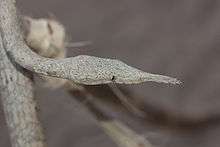Langaha madagascariensis
Langaha madagascariensis (formerly Langaha nasuta, commonly known as the Madagascar or Malagasy leaf-nosed snake) is a medium-sized highly cryptic arboreal species. It is endemic to Madagascar and found in deciduous dry forests and rain forests, often in vegetation 1.5 to 2 meters above the ground.[1][3]
| Langaha madagascariensis | |
|---|---|
 | |
| Female L. madagascariensis | |
| Scientific classification | |
| Kingdom: | Animalia |
| Phylum: | Chordata |
| Class: | Reptilia |
| Order: | Squamata |
| Suborder: | Serpentes |
| Family: | Lamprophiidae |
| Genus: | Langaha |
| Species: | L. madagascariensis |
| Binomial name | |
| Langaha madagascariensis Bonnaterre, 1790 | |
| Synonyms | |
| |

Description
Malagasy leaf-nosed snakes can grow up to 1 meter in length.[3] There is considerable sexual dimorphism within the species; the males are dorsally brown and ventrally yellow with a long tapering snout, while the females are mottled grey with a flattened, leaf shaped snout.[4] The function of their appendage is unknown, but obviously also serves as camouflage.[3]
It is largely a sit-and-wait predator. It may show curious resting behaviour, hanging straight down from a branch. Prey items include arboreal and terrestrial lizards.[5] It also exhibits hooding while stalking prey. These hooding and swaying behaviours along with its cryptic colour patterns, might allow L. madagascariensis to mimic a vine swaying in the wind.[6]
Leaf-nosed snakes are oviparous with clutch sizes ranging from 5 to 11 eggs.[3] Malagasy leaf-nosed snakes are generally calm and reluctant to bite unless provoked. Envenomation by the snake causes severe pain in humans, but is not deadly.[7]
References
- Raxworthy, C.J. (2011). "Leaf Nosed Snake". IUCN Red List of Threatened Species. 2011. Retrieved 2 June 2013.CS1 maint: ref=harv (link)
- Langaha madagascariensis at the Reptarium.cz Reptile Database. Accessed 3 May 2015.
- Glaw, Frank; Vences, Miguel (2007). A Field Guide to Amphibians and Reptiles of Madagascar (3rd ed.). Köln: M. Vences & F. Glaw Verlags GbR. ISBN 978-3-929449-03-7.
- Andrew Durso (February 7, 2013). "Malagasy Leaf-nosed Snakes". Life is Short, but Snakes are Long. Retrieved 2 June 2013.
- Tingle, Jessica L. (2012). "Field observations on the behavioral ecology of the Madagascan leaf-nosed snake, Langaha madagascariensis" (PDF). Herpetological Conservation and Biology. 7 (3): 442–448.
- Kenneth L. Ksyco (2005). "Feeding behaviour of the Madagascar leaf‐nosed snake, Langaha madagascariensis (Serpentes: Colubridae: Pseudoxyrhophiinae), with an alternative hypothesis for its bizarre head structure". African Journal of Herpetology. 54:2: 195–200. doi:10.1080/21564574.2005.9635534.
- D'Cruze, Neil C. (2008). "Envenomation by the Malagasy colubrid snake Langaha madagascariensis". Journal of Venomous Animals and Toxins Including Tropical Diseases. 14 (3): 546–551. doi:10.1590/S1678-91992008000300014.
| Wikimedia Commons has media related to Langaha madagascariensis. |
